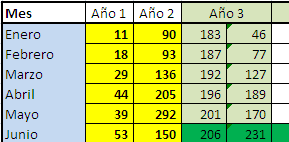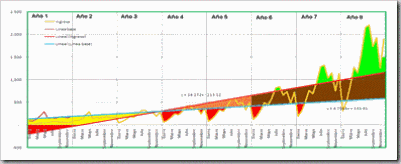The full post is in the Blogos, a stance on the possibility for making a monitoring plan for AdSense revenue by applying a linear graph of type mx+b. I confess that I have take part of the content.
Here I leave the review…
1. The base data
blah blah blah based on two years of data …
2. The projection
After entering the data, we can then calculate the expected value in the line graph of the year, which will behave in the form y = mx + b
 m is the slope (derivative), in this case we find a 4.63, x is equal to the number of months starting each year from 1 to 12. M may be higher to the extent that well-planned SEO measures will be applied, but 4.63 is a reference point in our case.
m is the slope (derivative), in this case we find a 4.63, x is equal to the number of months starting each year from 1 to 12. M may be higher to the extent that well-planned SEO measures will be applied, but 4.63 is a reference point in our case.
b is the abscissa intersect, it will be equal to the cumulative drop value, it is as I said before in 33% on the year’s increase plus a 10% increase that Google gives us by fidelity (or consolation). It is also likely that this is a result that traffic is growing to the extent that keeps a constant publication, a well-defined segment and there are not penalize advertising practices.
Thus the graph for the first year starting from scratch would be
y=4.52 X + 18.81 (with an annual average of $48)
y=4.73 X + 133.91 (with an annual average of $165)
y=4.63 X + 177.98 (with an annual average of $208)
y=4.63 X + 240.27

The chart shows the different stages as it would be made by a marketing plan:
The red zone … It adapts well to the introduction stage in the products life cycle.
The yellow zone: … It adapts to the growth stage.
The orange zone: … It adapts to the stage of maturity.
The coffee area: … This is adapted to the saturation cycle.
The green area: … good time to consider a new product curve … because the decline stage can come if you do not have something in mind for later.
Monitoring
If there is a comparative framework, then it could be a way to go applying changes, efforts and warnings to see if they show better results. As said, I’m in 4th year, which average I can expect at least, what would my likely income in May and what is the worst fall I can accept.
The graph shows several fields that can be used to check if the behavior is the expected minimum. The yellow spaces can be used based on real data; at least for two years, then the columns from year 3 include an expected minimum value and minimum falls and likely increases.
3. Contingencies
There are some aspects that are not predictable, among them we can mention:
- A wiggle
- The post-wiggle
- The low traffic cycles
- Security Flaws
- Other unforeseen
Blah, blah, blah … some of these contingencies can be prevented, others … not.
4. Conclusions
– Although there are those who believe that it is not necessary the initial investment, or it’s possible to do it by you, from this will depend on achieving a derivative above 4.5%. Among the likely investments it can be considered not punishable by Google advertising, search engine optimization, creative design, branding, among others.
-The study reflects the income average of the year, it may be the average income of May and June.
-If this data is known, having this average can be considered that total income for the year will be the average multiplied by 12
-From the third year a minimum graphic projection can be done in case of having exceeded the 4.5% derivative it could be expected a 6.5% and a plan for this.
-The results show that the best months are July and August (although they are result of the previous two months) and that the worst falls are in January and September.
-This suggests that three years are the time that a blog should require to be a differentiated and recognized brand.
What a shame, that site is not available.
 Autocad Software, Bentley Microstation, Gis Google Earth, Gis System Geomate Provides Services For Complete Gis Software And Solutions, Autocad Software, Autocad Courses, Bentley Microstation, Microstation Software, Gis Google Earth, Open Source Gis And More.
Autocad Software, Bentley Microstation, Gis Google Earth, Gis System Geomate Provides Services For Complete Gis Software And Solutions, Autocad Software, Autocad Courses, Bentley Microstation, Microstation Software, Gis Google Earth, Open Source Gis And More.